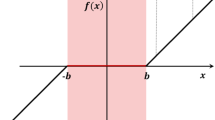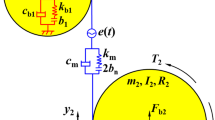Abstract
Vibrations on gears are mainly induced by the gear mesh contact. Resonance conditions of the gear may occur during service if the mesh frequency is close to the natural frequencies of the system at the designed speed of the shaft. Since detuning is not always possible in gears, the response level must be reduced by increasing the damping of the system.
In this paper, a passive approach based on the application of a ring damper to reduce the vibration level is presented.
The ring damper is placed in a groove underneath the outer rim of the gear. The contact is guaranteed by the preload due to the elasticity of the ring damper itself and above all by the centrifugal force that presses the damper against the groove during rotation. The relative motion of the two components at the contact interface dissipates energy by friction, and hence damping is generated. The vibration amplitude is reduced by optimizing the material and geometrical properties of the ring damper. One of the most important parameters in the determination of the amount of damping due to friction phenomena is the static normal load at the contact, which depends on the mass, the shape, and the material of the ring damper.
A numerical method is presented, which couples the static and dynamic equilibrium equations of the assembly. The core of the proposed method is the contact element that takes into account local stick–slip–lift off of the contact and determines the contact forces in terms of static and dynamic loads, which are then used to solve the coupled static and dynamic equilibrium. Since the ring damper has a cut that breaks its continuous circular shape in order to be fitted on the groove, the hypothesis of cyclic symmetry for the gear/ring–damper assembly fails. As a consequence, an appropriate reduced-order modeling is presented to allow the forced response calculations.
The algorithm is applied to a dummy bevel gear and to a ring damper having a flat punch contact area. The forced response calculations are performed to highlight the nonlinear interaction between the gear and damper by varying the parameters that mainly affect the amount and distribution of the contact forces and therefore the response level.


















Similar content being viewed by others
References
Ewins, D.J.: Control of vibration and resonance in aero engines and rotating machinery—an overview. Int. J. Press. Vessels Piping 87, 504–510 (2010)
Firrone, C.M., Zucca, S.: Modelling friction contacts in structural dynamics and its application to turbine bladed disks. In: Awrejcewicz, J. (ed.) Numerical Analysis—Theory and Application. InTech, Rijeka (2011)
Seong, J.-Y., Min, K.-W., Kim, J.-C.: Analytical investigation of an SDOF building structure equipped with a friction damper. Nonlinear Dyn. (2012). doi:10.1007/s11071-012-0446-7
Laxalde, D., Thouverez, F., Sinou, J.J., Lombard, J.P.: Qualitative analysis of forced response of blisks with friction ring dampers. Eur. J. Mech. A, Solids 26, 676–687 (2007)
Liang, Z., Lin, L.: The dynamic frictional performance of damping-rings in labyrinth air seal for vibration control. In: ASME Proceedings of the ASME Turbo Expo 2009: Power for Land, Sea and Air, Orlando, Florida, June 8–12 (2009)
Tangpong, X.W., Wickert, J.A., Akay, A.: Finite element model for hysteretic friction damping of traveling wave vibration in axisymmetric structures. J. Vib. Acoust. 130, 011005 (2008)
Laxalde, D., Thouverez, F., Lombard, J.P.: Forced response analysis of integrally bladed disks with friction ring dampers. J. Vib. Acoust. 132, 011013 (2010)
Zucca, S., Firrone, C.M., Facchini, M.: A method for the design of ring dampers for gears in aeronautical applications. J. Mech. Des. 134, 091003 (2012)
Carmignani, C., Forte, P., Melani, G.: Numerical investigation on travelling wave vibration of bevel gears. In: ASME 2007 International Design Engineering Technical Conferences & Computers and Information in Engineering Conference IDETC/CIE, Las Vegas, Nevada, USA, 4–7 September 2007
Castanier, M.P., Ottarsson, G., Pierre, C.: A reduced order modeling technique for mistuned bladed disks. J. Vib. Acoust. 119, 439–447 (1997)
Hurty, W.C.: Dynamic analysis of structural systems using component modes. AIAA J. 3(4), 678–685 (1965)
Craig, R.R., Bampton, M.C.C.: Coupling of substructures for dynamics analyses. AIAA J. 6(7), 1313–1319 (1968)
Cardona, A., Lerusse, A., Geradin, M.: Fast Fourier nonlinear vibration analysis. Comput. Mech. 22, 128–142 (1998)
Griffin, J.H.: Friction damping of resonant stresses in gas turbine engine airfoils. J. Eng. Power 102, 329–333 (1980)
Yang, B.D., Chu, M.L., Menq, C.H.: Stick-slip-separation analysis and non-linear stiffness and damping characterization of friction contacts having variable normal load. J. Sound Vib. 210, 461–481 (1998)
Petrov, E.P., Ewins, D.J.: Analytical formulation of friction interface elements for analysis of nonlinear multiharmonic vibrations of bladed discs. J. Turbomach. 125, 364–371 (2003)
Cigeroglu, E., An, N., Menq, C.-H.: A microslip friction model with normal load variation induced by normal motion. Nonlinear Dyn. 50, 609–626 (2007)
Griffin, J.H., Menq, C.H.: Friction damping of circular motion and its implications to vibration control. J. Vib. Acoust. 113, 225–229 (1991)
Sanliturk, K.Y., Ewins, D.: Modelling two-dimensional friction contact and its application using harmonic balance method. J. Sound Vib. 193, 511–523 (1996)
Yang, B.D., Menq, C.H.: Characterization of 3D contact kinematics and prediction of resonant response of structures having 3D frictional constraint. J. Sound Vib. 217, 909–925 (1998)
Cigeroglu, E., An, N., Menq, C.H.: Forced response prediction of constrained and unconstrained structures coupled through frictional contacts. J. Eng. Gas Turbines Power 131, 022505 (2009)
Petrov, E.P., Ewins, D.J.: Advanced modeling of underplatform friction dampers for analysis of bladed disk vibration. J. Turbomach. 129, 143–150 (2007)
Siewert, C., Panning, L., Wallaschek, J., Richter, C.: Multiharmonic forced response analysis of a turbine blading coupled by nonlinear contact forces. In: ASME Turbo Expo 2009: Power for Land, Sea and Air, GT2009-59201, Orlando, Florida, USA, 8–12 June 2009
Zucca, S., Botto, D., Gola, M.M.: Range of variability in the dynamics of semi-cylindrical friction dampers for turbine blades. In: Proceedings of the ASME Turbo Expo 2008, Berlin, Germany, vol. 5, pp. 519–529 (2008)
Firrone, C.M., Zucca, S.: Underplatform dampers for turbine blades: the effect of damper static balance on the blade dynamics. Mech. Res. Commun. 36, 515–522 (2009)
Firrone, C.M., Zucca, S., Gola, M.M.: The effect of underplatform dampers on the forced response of bladed disks by a coupled static/dynamic harmonic balance method. Int. J. Non-Linear Mech. 46, 363–375 (2011)
Zucca, S., Firrone, C.M., Gola, M.M.: Numerical assessment of friction damping at turbine blade root joints by simultaneous calculation of the static and dynamic contact loads. Nonlinear Dyn. 67, 1943–1955 (2012)
Petrov, E.P.: Explicit finite element models of friction dampers in forced response analysis of bladed discs. In: ASME Turbo Expo 2007: Power for Land, Sea and Air, GT2007-27980, Montreal, Canada, 14–17 May 2007
Petrov, E.P., Ewins, D.J.: Effects of damping and varying contact area at blade-disk joints in forced response analysis of bladed disk assemblies. J. Turbomach. 128, 403–410 (2006)
Petrov, E.P., Ewins, D.J.: Advanced modeling of underplatform friction dampers for analysis of bladed disk vibration. J. Turbomach. 129, 143–150 (2007)
Laxalde, D., Gibert, C., Thouverez, F.: Experimental and numerical investigations of friction rings damping of blisks. In: Proceedings of ASME Turbo Expo 2008: Power for Land, Sea and Air, Berlin, Germany, June 9–13 (2008)
Author information
Authors and Affiliations
Corresponding author
Rights and permissions
About this article
Cite this article
Firrone, C.M., Zucca, S. Passive control of vibration of thin-walled gears: advanced modelling of ring dampers. Nonlinear Dyn 76, 263–280 (2014). https://doi.org/10.1007/s11071-013-1125-z
Received:
Accepted:
Published:
Issue Date:
DOI: https://doi.org/10.1007/s11071-013-1125-z




